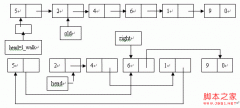浅析C/C++中sort函数的用法
sort是STL中提供的算法,头文件为#include<algorithm>以及using namespace std; 函数原型如下:
template <class RandomAccessIterator> void sort ( RandomAccessIterator first, RandomAccessIterator last ); template <class RandomAccessIterator, class Compare> void sort ( RandomAccessIterator first, RandomAccessIterator last, Compare comp );
使用第一个版本是对[first,last)进行升序排序,默认操作符为"<",第二个版本使用comp函数进行排序控制,comp包含两个在[first,last)中对应的值,如果使用"<"则为升序排序,如果使用">"则为降序排序,分别对int、float、char以及结构体排序例子如下:
#include<stdio.h>
#include<algorithm>
#include<string>
using namespace std;
struct product{
char name[16];
float price;
};
int array_int[5]={4,1,2,5,3};
char array_char[5]={'a','c','b','e','d'};
double array_double[5]={1.2,2.3,5.2,4.6,3.5};
//结构比较函数(按照结构中的浮点数值进行排序)
bool compare_struct_float(const product &a,const product &b){
return a.price<b.price;
}
//结构比较函数(按照结构中的字符串进行排序)
bool compare_struct_str(const product &a,const product &b){
return string(a.name)<string(b.name);
}
//打印函数
void print_int(const int* a,int length){
printf("升序排序后的int数组:\n");
for(int i=0; i<length-1; i++)
printf("%d ",a[i]);
printf("%d\n",a[length-1]);
}
void print_char(const char* a,int length){
printf("升序排序后的char数组:\n");
for(int i=0; i<length-1; i++)
printf("%c ",a[i]);
printf("%c\n",a[length-1]);
}
void print_double(const double* a,int length){
printf("升序排序后的dobule数组:\n");
for(int i=0; i<length-1; i++)
printf("%.2f ",a[i]);
printf("%.2f\n",a[length-1]);
}
void print_struct_array(struct product *array, int length)
{
for(int i=0; i<length; i++)
printf("[ name: %s \t price: $%.2f ]\n", array[i].name, array[i].price);
puts("--");
}
void main()
{
struct product structs[] = {{"mp3 player", 299.0f}, {"plasma tv", 2200.0f},
{"notebook", 1300.0f}, {"smartphone", 499.99f},
{"dvd player", 150.0f}, {"matches", 0.2f }};
//整数排序
sort(array_int,array_int+5);
print_int(array_int,5);
//字符排序
sort(array_char,array_char+5);
print_char(array_char,5);
//浮点排序
sort(array_double,array_double+5);
print_double(array_double,5);
//结构中浮点排序
int len = sizeof(structs)/sizeof(struct product);
sort(structs,structs+len,compare_struct_float);
printf("按结构中float升序排序后的struct数组:\n");
print_struct_array(structs, len);
//结构中字符串排序
sort(structs,structs+len,compare_struct_str);
printf("按结构中字符串升序排序后的struct数组:\n");
print_struct_array(structs, len);
}
sort函数的用法
做ACM题的时候,排序是一种经常要用到的操作。如果每次都自己写个冒泡之类的O(n^2)排序,不但程序容易超时,而且浪费宝贵的比赛时间,还很有可能写错。STL里面有个sort函数,可以直接对数组排序,复杂度为n*log2(n)。使用这个函数,需要包含头文件。
这个函数可以传两个参数或三个参数。第一个参数是要排序的区间首地址,第二个参数是区间尾地址的下一地址。也就是说,排序的区间是[a,b)。简单来说,有一个数组int a[100],要对从a[0]到a[99]的元素进行排序,只要写sort(a,a+100)就行了,默认的排序方式是升序。
拿我出的“AC的策略”这题来说,需要对数组t的第0到len-1的元素排序,就写sort(t,t+len);
对向量v排序也差不多,sort(v.begin(),v.end());
排序的数据类型不局限于整数,只要是定义了小于运算的类型都可以,比如字符串类string。
如果是没有定义小于运算的数据类型,或者想改变排序的顺序,就要用到第三参数——比较函数。比较函数是一个自己定义的函数,返回值是bool型,它规定了什么样的关系才是“小于”。想把刚才的整数数组按降序排列,可以先定义一个比较函数cmp
bool cmp(int a,int b)
{
return a>b;
}
排序的时候就写sort(a,a+100,cmp);
假设自己定义了一个结构体node
struct node{
int a;
int b;
double c;
}
有一个node类型的数组node arr[100],想对它进行排序:先按a值升序排列,如果a值相同,再按b值降序排列,如果b还相同,就按c降序排列。就可以写这样一个比较函数:
- 上一篇:C++虚函数表实例分析
- 下一篇:c++11新增的便利算法实例分析





